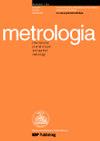Length measurement based on multi-wavelength interferometry using numerous stabilized frequency modes of an optical comb
IF 2.4
3区 工程技术
Q2 INSTRUMENTS & INSTRUMENTATION
引用次数: 0
Abstract
The electro-optic comb (EO comb) with a relatively wide mode spacing of 25 GHz can be resolved into individual frequency modes with a commercially available high-resolution spectrometer. The EO comb has numerous discrete frequency modes, which can serve as a light source for a monochromatic laser interferometer to realize the meter. In this study, a method for measuring the absolute distances based on the multi-wavelength interferometer principle is proposed and demonstrated by simultaneously implementing 102 monochromatic laser interferometers using an EO comb. A phase shifting technique was used to determine the phase for each frequency mode by precisely translating a reference mirror with a constant interval. The phases of the interference signals for 102 stabilized individual frequency modes were measured by applying the model-based analysis on the phase-shifted interference signals. The absolute distance can be determined using phase values of a wavelength set corresponding to five to seven randomly selected frequency modes. In this study, the absolute distances for round-trip distances of 166 mm and 1316 mm were measured and the measurement uncertainty of each distance was evaluated. Through the uncertainty analysis of the distance measurement, the combined uncertainties of the measured distances in a short and long ranges were evaluated to be 30.1 nm and 211.1 nm, respectively. In addition, for each distance, the consistent measurement results of absolute distances were obtained through four different wavelength sets, which show the flexibility of wavelength selection in this work.基于多波长干涉测量法的长度测量,使用光学梳的众多稳定频率模式
电光梳(EO comb)的模式间距相对较宽,为 25 千兆赫,可利用市售的高分辨率光谱仪将其解析为单个频率模式。环光学梳具有许多离散的频率模式,可以作为单色激光干涉仪的光源来实现测量。本研究提出了一种基于多波长干涉仪原理的绝对距离测量方法,并通过使用环氧乙烷梳同时实施 102 个单色激光干涉仪进行了演示。采用相移技术,通过以恒定间隔精确平移参考镜来确定每个频率模式的相位。通过对相移干涉信号进行基于模型的分析,测量了 102 个稳定的单个频率模式的干涉信号的相位。绝对距离可以通过与随机选择的五到七个频率模式相对应的波长集的相位值来确定。本研究测量了 166 毫米和 1316 毫米往返距离的绝对距离,并评估了每个距离的测量不确定性。通过对距离测量的不确定度分析,估算出短距离和长距离测量距离的综合不确定度分别为 30.1 nm 和 211.1 nm。此外,对于每个距离,通过四组不同的波长,都获得了一致的绝对距离测量结果,这显示了这项工作在波长选择上的灵活性。
本文章由计算机程序翻译,如有差异,请以英文原文为准。
求助全文
约1分钟内获得全文
求助全文
来源期刊

Metrologia
工程技术-物理:应用
CiteScore
2.80
自引率
25.00%
发文量
137
审稿时长
12 months
期刊介绍:
Published 6 times per year, Metrologia covers the fundamentals of measurements, particularly those dealing with the seven base units of the International System of Units (metre, kilogram, second, ampere, kelvin, candela, mole) or proposals to replace them.
The journal also publishes papers that contribute to the solution of difficult measurement problems and improve the accuracy of derived units and constants that are of fundamental importance to physics.
In addition to regular papers, the journal publishes review articles, issues devoted to single topics of timely interest and occasional conference proceedings. Letters to the Editor and Short Communications (generally three pages or less) are also considered.
 求助内容:
求助内容: 应助结果提醒方式:
应助结果提醒方式:


